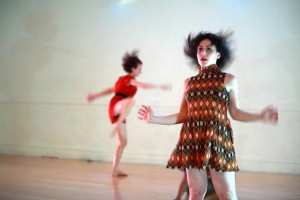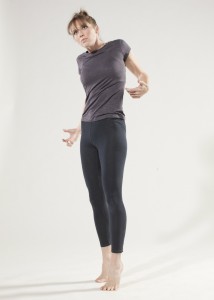1. What is your background in dance?
I’m originally from upstate New York and spent my growing up years in Pittsburgh, PA training at the Civic Light Opera Academy before attending VA Commonwealth University to study dance, and graduating from The Ohio State University (OSU) with a BFA in Dance. I’ve had formal training in ballet, jazz, modern, postmodern, and improvisational dance techniques, finding my home in choreography while an undergraduate student. After moving to Chicago after graduation in 2003, I continued to make work while attaining my Pilates Certification and Graduate Laban Certificate in Movement Analysis from Columbia College Chicago. The most influential tools for developing my choreographic ‘style’ and vision as a choreographer developed during this time through the studies of Rudolf Laban and choreographic workshops with Susan Rethorst and Jeanine Durning. I formed my nonprofit dance company The Moving Architects in 2007 when I felt ready to create a more stable framework and formal presence as a choreographer.

2. What are you currently doing?
I am currently Artistic Director of The Moving Architects, choreographing, performing, and teaching nationally and internationally, while also a graduate student pursuing my MFA in Dance at OSU. I have my hands in many projects. I am continuing to collaborate with my longtime musician Ian Hatcher and filmmaker Andrea Slavik while working with dancers in Columbus and Chicago on short-term and long-term dance projects. My choreographic research is taking me around the world in the coming months as I engage in contemporary and traditional global dance practices from the research perspective of dance instructor, choreographer, and film documentarian, teaching and performing in Guatemala with the Tercer Festival Internacional de Danze Antigua and in Morocco with Action Danse 5 Festival. I’m asking questions such as how can contemporary modern dance be shared internationally? How can cross-cultural dance experiences be translated into creative choreographic processes? This year I’ve also had the valuable opportunity to be graduate assistant to choreographer and Professor Bebe Miller.
3. What is your chorographic process typically like?
I have been working on thematic evening-length dance works that are generally 1-2 year creative projects. In 2009 we presented “Stops on the Line” based around ideas of Chicago’s Union Station train station, in 2010 “Sacred Spaces” was inspired by religious architecture, and last year we premiered “PLUCK” that dealt with ideas of power and was largely created over Skype. The threads of these major works can be traced from one piece to the next as I have increased development of movement vocabulary and work more and more collaboratively with my dancers in the studio. One of my rehearsal traits is making decisions based on visual, rather than kinesthetic, choices. I will come to the studio with movement phrase work and demonstrate it as the dancers and I little by little tweak and tease out the true essence of the idea.
4. Can you tell readers a bit about The Moving Architects?
The company has had successful and unique opportunities since its formation – bringing full productions to untraditional church spaces, performing in Tennis Courts and art centers throughout the Midwest and nationally, last year performing and teaching throughout Tajikistan and Kyrgyzstan through the U.S. Department of State. One of the foundations of the company in my original vision was to “create dance works where space informs the work” and this has been continually true in more ways than I ever imagined through the choreographic themes, venues, and international experiences.
5. You have a show coming up – can you talk a little about it?
SECTOR is a collection of works I’ve invested in over the past two years that share similar physicalities –bound, angular, ‘fierce’ movement- alongside my interests in power struggles, hierarchies, and in-the-moment alertness and attitude.
6. How did you go about choreographing this particular work?
The work contains five sections that I view as five communities/tribes/sects of a culture that are each similar to each other yet unique in their relationships and regional identities. I see these community tensions in the world around me and choose to approach these charged and relevant issues through the moving body.
7. What would you like the audience to know about this particular production?
This work is a further investigation of last year’s “PLUCK”, influenced by my studies of dance in global, social, and political contexts; studying and practicing of Gaga technique; and our travels to Central Asia.
8. What role do the dancers play in your work?
The dancers are the work. Their focus, commitment, persistence, smarts, input, training, willingness to join me in the process and investigation – this makes the work.
9. How do you see dance evolving overall? Do you think there is a particular direction it is headed?
I think that dance is heading in two directions wherein dancemakers are investigating new creative processes and asking different questions. I see work continuing to explore the use of technology with the inclusion of collaborators/experts in the fields of visual arts, animation, dramaturgy, film, live music, etc. which I’ve seen recently and in new ways with Zoe Zuniper and Kid Pivot. I also see a re-investigation of movement frameworks and the possibilities of the finely tuned human body in such companies as Batsheva Dance Company and Forsythe Company.
10. What is next for you?
In the coming year I will be rigorously focused on researching, writing, and asking questions about dance in cross-cultural contexts, translating my travels and experiences into choreography and making a short documentary to complete my MFA in Dance. Our travels to Central Asia had a profound effect on me and I look forward to how these ongoing studies will continue to shape and inform the company and future projects.

Bio: Erin Carlisle Norton is the Artistic Director of the Chicago, USA-based dance company The Moving Architects. She holds a Bachelor of Fine Arts in Dance from The Ohio State University, a Graduate Laban Certificate in Movement Analysis from Columbia College Chicago, Pilates Certification, and is currently pursuing her Master of Fine Arts in Dance at The Ohio State University. She has trained under choreographers and dance instructors including Susan Hadley (Mark Morris Group), Bebe Miller (Bebe Miller Company), Jeanine Durning, Norah Zuniga-Shaw (William Forsythe collaborator), Susan Rethorst, and Paula Kellinger. Her choreography has been presented throughout the United States since 2003, with highlights at Chicago’s The Other Dance Festival, Fasseas White Box Theater, Church of the Epiphany, and St. Pauls Chapel, as well as Wellspring Theater (Michigan); Sentry Theater (Wisconsin), Wilson College (Pennsylvania); Chez Bushwick (New York City); Movement Research (New York City) and in Tajikistan and Kyrgyzstan through the US Embassy/Department of State. Her work has been featured in traditional and site-specific locations including art galleries, church spaces, tennis courts, and restaurants. Erin has taught at dance and Pilates studios throughout the country in academic and community settings, including beginners, professionals, people with disabilities, and as guest artist at University of Chicago, Western Michigan University, University of Wisconsin-Stevens Point, Beloit College, and The Moving Architects Summer Dance Retreat at Wilson College. As a choreographer she has received multiple grants from Ohio State University, The Driehaus Foundation, Chicago Cultural Center, The Illinois Arts Council, Columbus Dances Fellowship 2011, and is an Artistic Associate at Chicago’s Links Hall. Erin’s current graduate research focuses on engaging in contemporary and traditional global dance practices from the research perspective of dance instructor, choreographer, and film documentarian in countries including Guatemala, Morocco, Kyrgyzstan, and Tajikistan.




